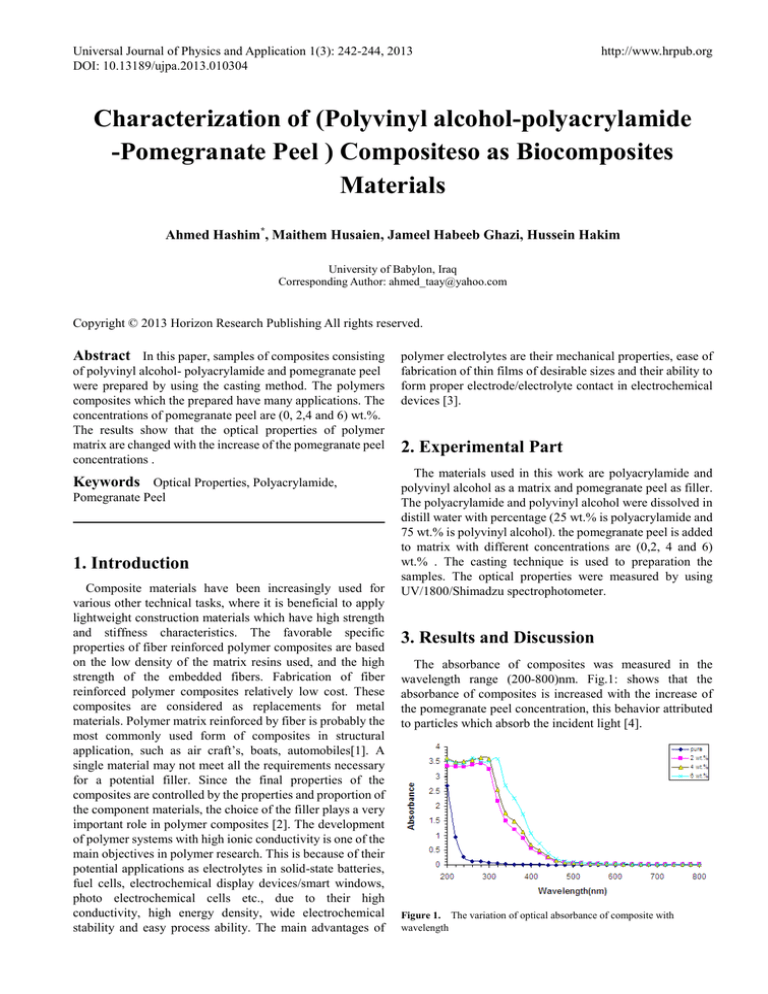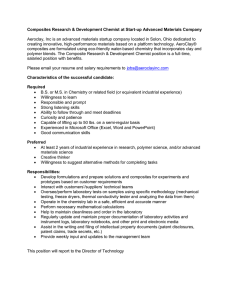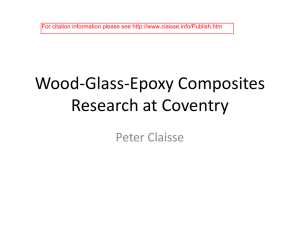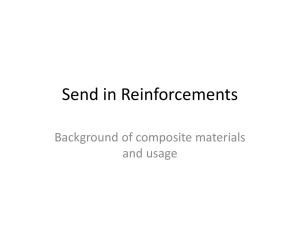
Universal Journal of Physics and Application 1(3): 242-244, 2013
DOI: 10.13189/ujpa.2013.010304
http://www.hrpub.org
Characterization of (Polyvinyl alcohol-polyacrylamide
-Pomegranate Peel ) Compositeso as Biocomposites
Materials
Ahmed Hashim*, Maithem Husaien, Jameel Habeeb Ghazi, Hussein Hakim
University of Babylon, Iraq
Corresponding Author: ahmed_taay@yahoo.com
Copyright © 2013 Horizon Research Publishing All rights reserved.
Abstract In this paper, samples of composites consisting
of polyvinyl alcohol- polyacrylamide and pomegranate peel
were prepared by using the casting method. The polymers
composites which the prepared have many applications. The
concentrations of pomegranate peel are (0, 2,4 and 6) wt.%.
The results show that the optical properties of polymer
matrix are changed with the increase of the pomegranate peel
concentrations .
Keywords Optical Properties, Polyacrylamide,
Pomegranate Peel
1. Introduction
Composite materials have been increasingly used for
various other technical tasks, where it is beneficial to apply
lightweight construction materials which have high strength
and stiffness characteristics. The favorable specific
properties of fiber reinforced polymer composites are based
on the low density of the matrix resins used, and the high
strength of the embedded fibers. Fabrication of fiber
reinforced polymer composites relatively low cost. These
composites are considered as replacements for metal
materials. Polymer matrix reinforced by fiber is probably the
most commonly used form of composites in structural
application, such as air craft’s, boats, automobiles[1]. A
single material may not meet all the requirements necessary
for a potential filler. Since the final properties of the
composites are controlled by the properties and proportion of
the component materials, the choice of the filler plays a very
important role in polymer composites [2]. The development
of polymer systems with high ionic conductivity is one of the
main objectives in polymer research. This is because of their
potential applications as electrolytes in solid-state batteries,
fuel cells, electrochemical display devices/smart windows,
photo electrochemical cells etc., due to their high
conductivity, high energy density, wide electrochemical
stability and easy process ability. The main advantages of
polymer electrolytes are their mechanical properties, ease of
fabrication of thin films of desirable sizes and their ability to
form proper electrode/electrolyte contact in electrochemical
devices [3].
2. Experimental Part
The materials used in this work are polyacrylamide and
polyvinyl alcohol as a matrix and pomegranate peel as filler.
The polyacrylamide and polyvinyl alcohol were dissolved in
distill water with percentage (25 wt.% is polyacrylamide and
75 wt.% is polyvinyl alcohol). the pomegranate peel is added
to matrix with different concentrations are (0,2, 4 and 6)
wt.% . The casting technique is used to preparation the
samples. The optical properties were measured by using
UV/1800/Shimadzu spectrophotometer.
3. Results and Discussion
The absorbance of composites was measured in the
wavelength range (200-800)nm. Fig.1: shows that the
absorbance of composites is increased with the increase of
the pomegranate peel concentration, this behavior attributed
to particles which absorb the incident light [4].
Figure 1. The variation of optical absorbance of composite with
wavelength
Universal Journal of Physics and Application 1(3): 242-244, 2013
The absorption coefficient (α) is defined by [4,5]:
α=2.303 A/d ……
243
The refractive index (n) of the composits is defined [7]:
…. [1]
Where A: is the absorbance of sample and d: is the sample
thickness.
Figure (2) represents the variation of absorption
coefficient of composites of different concentration of filler
with the photon energy..
Figture 2. The absorption coefficient of composite with various photon
energy
From the figure, the absorption coefficient of composites
less than 104 cm-1 which refer to the composites have indirect
energy band gap which calculated by[6]:
n= (1+R1/2)/ (1-R1/2 ) ……
… [3]
Where R is reflectance
The extinction coefficient (k) of composites is calculated by
[7]:
k=αλ/4π ……
…… [4]
The behavior of refractive index and extinction coefficient
of the composites with photon energy are shown in figures
( 5 and 6 ). The refractive index of matrix of polymers is
increased with the increase of the concentration of the
pomegranate peel as result to increase the scattering of light
because increase the density of polymers with increase the
concentration of the pomegranate peel. The extinction
coefficient of composite polymer is increased with the
increase of the percentages of potassium chloride as result to
the increase the loss of energy of incident light by the
particles of composites [7,8].
The dielectric constants (real (ε1) and imaginary (ε2) parts)
are defined by[9]:
ε1=n2-k2
[5]
ε2=2nk
[6]
r
αhυ=B(hυ-Eg) ……………………….[2]
Where: hυ is the photon energy, B is a constant, Eg is the
energy band gap, r=2 and 3 for allowed and forbidden
indirect transition. The increase of the concentration of filler
is produced increase of the localized states in the forbidden
gap which decreases the optical energy gap [6] as shown in
figures(3 and 4).
Figure 5. The relationship between refractive index of composite with
photon energy
Figure 3. The relationship between (αhu)1/2(cm-1 eV)1/2 and photon
energy of composites
Figure 6. The extinction coefficient of composite with various photon
energy
Figure 4. The relationship between (αhu)1/3(cm-1 eV)1/3 and photon
energy of composites
Figures (7) and (8) show the variation of real and
imaginary parts of dielectric constants of composites with
different concentration of filler. From these figures, the real
and imaginary parts of dielectric constants are increased
with the increase of the concentration of the pomegranate
peel which attributed to increase the scattering and loss of
244
Characterization of (Polyvinyl alcohol-polyacrylamide-Pomegranate Peel ) Compositeso as Biocomposites Materials
energy of light in the material which increase the refractive
index and extinction coefficient [9].
REFERENCES
Figure 7. The variation of real part of dielectric constant of composite
with photon energy
Figure 8. The variation of imaginary part of dielectric constant of
composite with photon energy
4. Conclusions
1.
2.
3.
The absorbance of the polyacrylamide- polyvinyl
alcohol is increased with the increase of the
pomegranate peel concentration.
The absorption coefficient, extinction coefficient,
refractive index and real and imaginary dielectric
constants the polyacrylamide- polyvinyl alcohol are
increasing with the increasing of the weight
percentages of pomegranate peel.
The indirect energy band gap of the polyacrylamidepolyvinyl alcohol is decreased with the increasing of
the pomegranate peel concentration.
[1]
K.Devendra1, T. Rangaswamy, 2012, Evaluation of Thermal
Properties of E-Glass/ Epoxy Composites Filled By
Different Filler Materials, International Journal Of
Computational Engineering Research, Vol. 2, No. 5, P. 17081714.
[2]
V. S. Vinod, Siby Varghese, Rosamma Alex, Baby Kuriakose,
2000, Effect of Aluminum Powder on Filled Natural Rubber
Composites, Rubber Chemistry and Technology, Vol. 74, P.
236-248.
[3]
U. Sasikala, P. Naveen Kumar, V.V.R.N.Rao and A. K.
Sharma, 2012, "structural, electrical and parametric studies of
PEO based polymer electrolyte for battery applications",
international journal of engineering science & advance
technology, Vol. 2, No. 33, PP. 722-730.
[4]
Ahmad A.H., Awatif A.M. and Zeid Abdul-Majied N., 2007,
“ J. of Eng. &Technology”, Vol.25, No.4, PP 558-568.
[5]
E.M. Abdelrazek , A.M. Abdelghany , A.H. Oraby and G.M.
Asnag, 2012, " Investigation of Mixed Filler Effect on
Optical and Structural Properties of PEMA Films",
International Journal of Engineering & Technology IJETIJENS Vol.12 No,4, PP. 98-102.
[6]
Hamed M. Ahmad, Sabah H. Sabeeh, Sarkawt A. Hussen,
2012, "Electrical and Optical Properties of PVA/LiI Polymer
Electrolyte Films", Asian Transactions on Science and
Technology, Vol. 1, No.6, PP.16-20.
[7]
Tariq J. Alwan, 2010, "Refractive Index Dispersion and
Optical Properties of Dye Doped Polystyrene Films",
Malaysian Polymer Journal, Vol. 5, No. 2, PP. 204-213. A.
Rawat, H. Mahavar, S. Chauhan, A. Tanwarand and P.Singh,
2012, " optical band gap of polyvinyl pyrrolidone/
polyacrilamide bland thin films", Indian journal of pure
applied physics, Vol. 50, PP. 100- 104.
[8]
E.I. Ugwu, 2006, " Optical Properties of Iron Halide (FeCl2)
Thin Film Deposited Using Solution Growth Technique
(SGT)", The Pacific Journal of Science and Technology , Vol.
7, No., 2, PP. 97-102.
[9]
Nahida. J. H. & Marwa. R. F, 2011, Study of the Optical
Constants of the PMMA/PC Blends, Eng. & Tech.
Journal ,Vol.29, No.4, PP. 698- 708.




